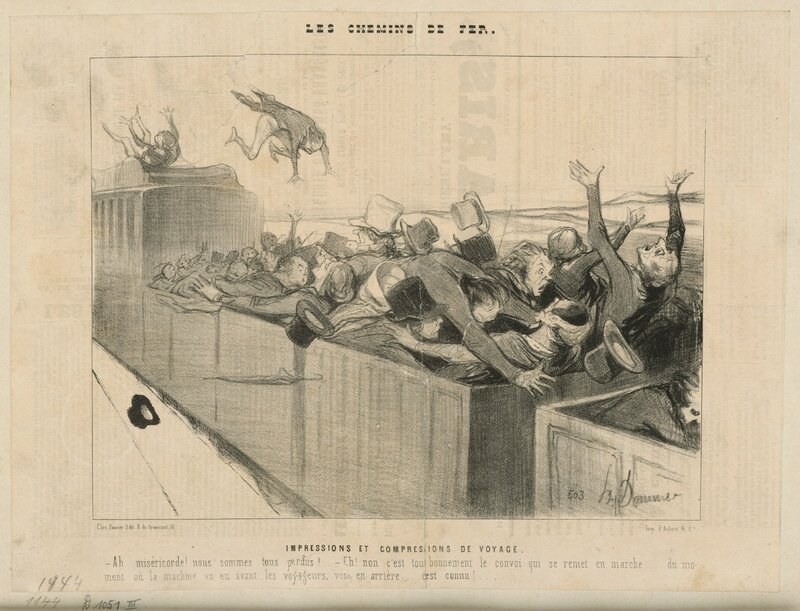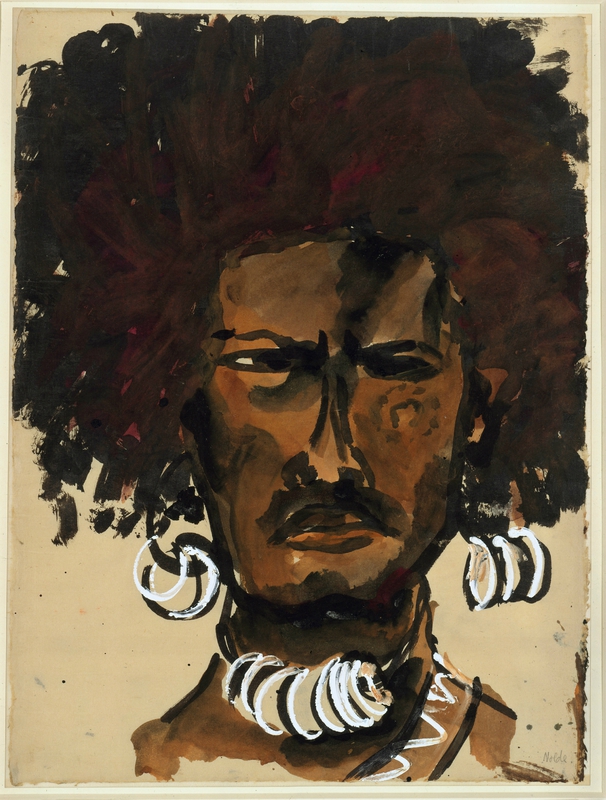"We're Off Then: Travel Pictures from Albrecht Dürer to Olafur Eliasson" on view at the Kupferstichkabinett
John Wesley, Black Car, 1989. Gouache. © John Wesley / © National Museums in Berlin, Kupferstichkabinett / Jörg P. Anders.
BERLIN.- Everyone is on a journey. Travelling, being on the road, mobility – all have been integral themes since the dawn of humanity. In its 2016 summer exhibition, Berlin’s Kupferstichkabinett is showing the most beautiful, seductive and curious travel pictures from over five centuries. The arc spans from gorgeously illustrated books from the Age of Discovery around the year 1500, via the art spawned by Humboldt's travels, the enigmatic paradises of Paul Gauguin and Nolde's deeply sceptical South Sea watercolours, right through to Ed Ruscha's 1960s gas station in middle-ofnowhere America and Franz Ackermann's “mental maps".
Emil Orlik, Fuji-pilgrims, 1901. Color woodcut. © National Museums in Berlin, Kupferstichkabinett / Jörg P. Anders
The theme of travel and art on paper are intricately connected – for the travel picture is based on mobile media. It is with notations in sketchbooks, drawings, watercolours and oil sketches that artists have swept us away to new, foreign worlds. It is precisely in the sanguine and pen-andink drawings, in the enchanting coloration of many sheets and the most diverse graphic techniques that the authenticity, mobility and spontaneity of travelling art is made directly visible, enabling us to experience its impact.
Charles Nicolas Cochin the Younger, Allegory of Asia - The journey of Don Quixote, 1688. Pen and black, watercolors. © National Museums in Berlin, Kupferstichkabinett.
The topic of travel and art on paper are closely connected – for the travel picture is based on mobile media. It is with notations in sketchbooks, drawings, watercolours and oil sketches that artists have swept us away to new, foreign worlds. It is precisely in the sanguine and pen-and-ink drawings, in the enchanting coloration of many sheets and the most diverse graphic techniques that the authenticity, mobility and spontaneity of travel art is made directly visible, enabling us to experience its impact.
Willem Buytewech, A traveling carriage, circa 1622. Pen and brown ink, over preliminary drawing with black pen. © National Museums in Berlin, Kupferstichkabinett / Jörg P. Anders.
The first of the six exhibition sections Mental Maps–The World on Paper deals with the pictorial knowledge of the Renaissance, with proximity and distance, with travelling with the eye and the medium of paper, with the mapped world, with concepts of the present and of globalization. In the next section Travel for Travel's Sake–Peregrination and Pilgrimage, we accompany wayfarers and travellers into the wide open landscapes of Europe, we encounter the pious pilgrims to the Einsiedeln Madonna by Master E.S. and Emil Orlik's pilgrims to Mt. Fuji. As travellers and illustrators, the artists themselves lead the way. Travelling by foot is followed by other means of locomotion – Planes, Trains and Automobiles– Transportation and Mobility: travellers on horseback, on ships, in horsedrawn carriages, on the train, in the car, on buses and planes. Daumier shows us the vagaries of a rail trip, Xaver Fuhr the eternal dream of flight. These excursions are followed by the “grand tour" (A Trip to Italy–Culture and Education). The cultural and educational journey to Italy has long been part of a 'gentleman's education', on which studies of the antique, architecture and landscapes were all part of the agenda. The journeys of discovery began in the early modern era, making the entire world tangible on paper. Here, in the section Around the World–Art and Science, we encounter indigenous clans from 17th century Brazil, the luminous watercolours of the Humboldt artists as they sketched out the world, and the global enchantment of a Paul Gauguin. In the final section Odyssey– Escapes, Inner and Final Journeys, the fantastic and abyssal sides of the pilgrimage on Earth are depicted. The focus is on fictional journeys from great literature, as well as odysseys, the journey as a search or a test, and – highly topical – forced journeys, flight, longed-for destinations and their disintegration.
Honoré Daumier, Impressions et compressions de voyage, from: Les chemins de fer (impressions and compressions on the trip, from: The railway), 1839-42. Chalk lithograph. © National Museums in Berlin, Kupferstichkabinett / Dietmar Katz.
With its summer exhibitions, the Kupferstichkabinett of the Staatliche Museen zu Berlin has introduced a new exhibition format to the German museum scene. The shows to date – The Art of Bathing (2014) and We Go to the Dogs (2015) – were met with a great deal of interest amongst the public and the press alike. The aim is to present our visitors with particularly attractive and popular themes from the history of art and culture during the summer months – the time of holidays, travelling and culture. Light-hearted elements also get a look in the exhibition.
Toggenburg Chronicle, Jacob moves his belongings to Egypt, 1411. Bodycolours on parchment. © National Museums in Berlin, Kupferstichkabinett / Knud Petersen.
Albrecht Dürer, Fortress on a mountain (Welsch Castle), about 1494 or 1495 to 1500. Watercolor and pen and black ink, heightened with white with brush. © National Museums in Berlin, Kupferstichkabinett / Jörg P. Anders.
Marten van Heemskerck, Kolossalfuß and portico Octaviae, circa 1532-36. Pen and brown ink. © National Museums in Berlin, Kupferstichkabinett / Jörg P. Anders.
James Tissot, Emigrants, 1880. Etching and drypoint. © National Museums in Berlin, Kupferstichkabinett / Dietmar Katz.
Eduard Hildebrandt, Beijing: Tientsin, 1863. Watercolor. © National Museums in Berlin, Kupferstichkabinett / Dietmar Katz.
Max Klinger, Wanderers end (Dying Walker), 1879. Etching and aquatint. © National Museums in Berlin, Kupferstichkabinett / Dietmar Katz.
Philip Pearlstein, View over Soho, Lower Manhattan, 1977-78. Aquatint and etching. © Philip Pearlstein / © National Museums in Berlin, Kupferstichkabinett / Dietmar Katz.
Emil Nolde, Manusmann, 1914. Watercolor, brush and black ink and opaque white. © Noldestiftung Seebüll / © National Museums in Berlin, Kupferstichkabinett / Jörg P. Anders.
Olafur Eliasson, Cartographic Series No. 3, 2004. Series of 30 photogravures. © Olafur Eliasson / © National Museums in Berlin, Kupferstichkabinett / Dietmar Katz.

/https%3A%2F%2Fprofilepics.canalblog.com%2Fprofilepics%2F1%2F0%2F100183.jpg)
/https%3A%2F%2Fstorage.canalblog.com%2F03%2F02%2F119589%2F96711876_o.jpg)
/https%3A%2F%2Fstorage.canalblog.com%2F11%2F31%2F119589%2F94773502_o.jpg)
/https%3A%2F%2Fstorage.canalblog.com%2F20%2F83%2F119589%2F94772815_o.jpg)
/https%3A%2F%2Fstorage.canalblog.com%2F26%2F72%2F119589%2F75604929_o.jpg)
/https%3A%2F%2Fstorage.canalblog.com%2F59%2F60%2F119589%2F26458628_o.jpg)
















/http%3A%2F%2Fstorage.canalblog.com%2F75%2F03%2F119589%2F112784440_o.jpg)
/http%3A%2F%2Fstorage.canalblog.com%2F54%2F97%2F119589%2F112048591_o.jpg)
/http%3A%2F%2Fstorage.canalblog.com%2F34%2F69%2F119589%2F111712013_o.jpg)
/http%3A%2F%2Fstorage.canalblog.com%2F44%2F96%2F119589%2F110091117_o.jpg)